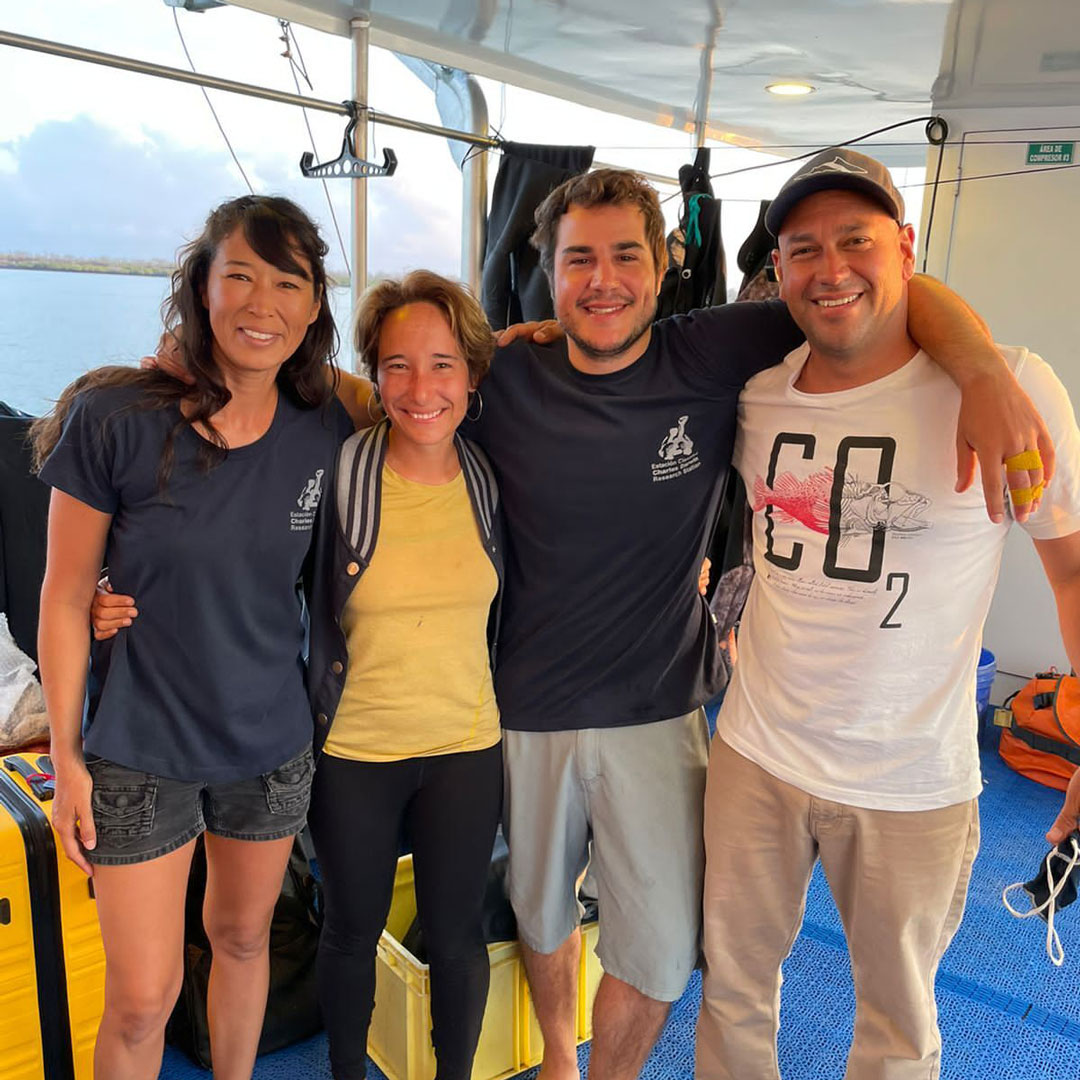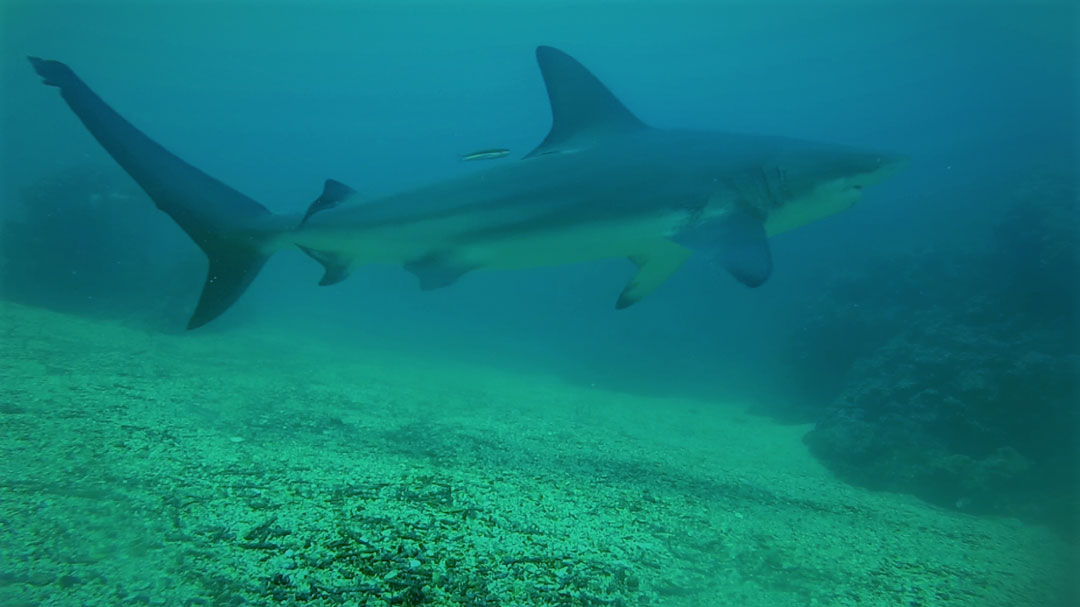Fulfilling sharky dreams
There is a saying that dreaming costs nothing. Over time, I have figured out that this is true! Putting in the time and dedication to what you love makes everything worthwhile: the seasickness and dizziness on the boat, the early morning tiredness, the bruises during fieldwork and whatever else you find on your way! When you live following your dreams, everything is an adventure!
My name is Ana Victoria Moya Serrano. I am a Galapagos resident. My conservation journey began when I was only seven years old when I watched a documentary about whaling. I decided that I would devote myself to protecting the ocean at that moment. Many years later, I started studying for a marine biology degree. By twists and turns of life, I arrived in Galapagos to work for the Charles Darwin Foundation Shark Ecology research project. This opportunity wide-opened the doors for me to be able to carry out my life goals.

The Shark team during the last fieldtrip in February. Photo © Charles Darwin Foundation.
Being part of the shark ecology team and contributing to fieldwork such as conducting shark surveys using Baited remote underwater video stations (BRUVS) and diver operated video (DOVS); deploying satellite tags on sharks; taking tissue biopsies for genetic and isotope analysis; and even desktop activities, such as video analysis and administrative duties, have generated a great impact in my personal and professional development. Each activity requires a specific level of concentration, time and effort that teaches you to be organised and pay attention to detail in every step to do a good job, be quick in decision making, and seek solutions when things do not go as planned. You also fully realise that the best way to achieve one goal is teamwork and that you always have to be open to enriching yourself from others and mistakes. It is a challenging but rewarding job.
When you have the opportunity to be close to sharks in the wild and, observe them in their habitat, study their behaviour and reactions, your mind expands. It is fantastic to see how each species has its own personality: the timid scalloped hammerhead shark, the curious silky shark; the highly territorial Galapagos shark; the cautious tiger shark; the fearless blacktip shark; or the gentle giant whale shark. When you are with them in the water, you change your perception of fear for respect and admiration and realise that just like us humans, sharks have their codes, and you just have to adjust to them.

Hammerhead shark (Sphyrna lewini) with a remora on its chin at Wolf Island recorded with a remote underwater video station. Photo © Charles Darwin Foundation.
I have also had the privilege of being in unimaginable places around the Galápagos Archipelago. Each one of the islands has its unique touch! The far northern islands of Darwin and Wolf are the perfect place to see enormous shivers of scalloped hammerhead sharks and huge whale sharks, and then when you least expect it, a group of orcas swim by! Travelling to the west of the archipelago, you can have the great experience of swimming alongside the magnificent oceanic mantas, which seem to fly in the great ocean; or suddenly encounter a giant turtle in the middle of a mangrove forest, peacefully eating on the rocks and looking at you with those eyes full of wisdom, and being surrounded by bubbles coming from shallow volcanic fumaroles at Roca Redonda transported me to another world!

A large male tiger shark (Galeocerdo cuvier) recorded with a BRUVS at Darwin Arch. Photo © Charles Darwin Foundation.
As part of my research assistant placement, I have been given the opportunity to develop and lead my own research topic, which I had to build from scratch. I must say that at the beginning, I was a bit lost and sometimes grew impatient and stubborn. But having a good guide between the lows and the highs, the expected results are obtained. My project is focused on cleaning stations and the dynamics that occur in these places that are so important for the health of sharks and the entire ecosystem. During our recent field trip in February, Remote Underwater Video Stations (RUVS) were placed in different cleaning stations to study the behaviour of sharks. It was incredible to witness how the dynamics and individuals’ presences change in each place.

Blacktip shark (Carcharhinus limbatus) using the cleaning services of a juvenile Cortez Rainbow Wrasses at Cabo Marshall, Isabela Island. Photo © Charles Darwin Foundation.
All these opportunities have been given thanks to the fact that there is a whole team of highly committed professionals working on the project that allowed it. These people, like me, make their conservation efforts daily and know that change comes through educating and integrating more people. Working for a cause always motivates you to continue dreaming.
↓ Versión en español a continuación ↓
Cumpliendo sueños con tiburones
Hay un dicho que dice que soñar no cuesta nada; con el tiempo he descubierto que es verdad. Dar tiempo y dedicación a lo que amas y suenas no cuesta nada, de hecho, lo disfrutas tanto que hace que todo valga la pena, los mareos, el cansancio, los morados y lo que venga. Cuando vives trabajando por un sueño, ¡todo es una aventura!
Mi nombre es Ana Victoria Moya Serrano, soy residente galapagueña, y mi travesía por la conservación empezó cuando tenía tan solo siete años mientras miraba un documental sobre la pesca de ballenas, en ese momento decidí que debía aportar de alguna forma para proteger el océano. Empecé estudiando biología marina y por vueltas de la vida llegue a Galápagos al proyecto “Ecología de Tiburones” de la Fundación Charles Darwin que me abrió las puertas para poder llevar acabo mi sueño.

The Shark team during the last fieldtrip in February. Photo © Charles Darwin Foundation.
Ser parte del proyecto de ecología de tiburones, y participiar en actividades de campo, como la colocación de estaciones de video remotas con carnada (BRUVS, siglas en ingles) y cámaras operadas por buzos (DOVS, siglas en inglés), la toma de biopsias para estudios genéticos y de isotopos, la colocación de marcas satelitales y hasta actividades de escritorio como el análisis de los videos y toda la parte administrativa han generado un gran impacto en mi desarrollo personal como profesional. Cada actividad requiere un nivel específico de concentración, tiempo y esfuerzo que, con el tiempo, te enseñan a ser organizado y estar atento a cada paso para realizar un buen trabajo, a ser rápido en tomar decisiones y a buscar soluciones, también descubres que la mejor forma de conseguir un objetivo es el trabajo en equipo y que siempre hay que estar abierto para enriquecerse de los demás y de los errores. Es un trabajo arduo pero gratificante.
Cuando tienes la oportunidad de estar cerca de estas especies y observarlas en su hábitat, ver su comportamiento y sus reacciones, tu mundo se expande. Es increíble ver como cada especie tiene su personalidad, desde tímidos tiburones martillo, curiosos tiburones sedosos, territoriales tiburones Galápagos, cautelosos tiburones tigre, hasta temerarios tiburones puntas negra y un calmado tiburón ballena. Cambias la percepción del miedo por respeto y admiración, y comprendes que al igual que los humanos, los tiburones tienen sus códigos y solo hay que adaptarse.

Hammerhead shark (Sphyrna lewini) with a remora on its chin at Wolf Island recorded with a remote underwater video station. Photo © Charles Darwin Foundation.
También he tenido el privilegio de estar en sitios inimaginables alrededor del Archipiélago. Cada uno con su toque único. Las Islas lejanas del Norte “Darwin y Wolf” son el lugar perfecto para ver escuelas inmensas de tiburones martillo y al gran tiburón ballena, y cuando menos te lo esperas, orcas inmensas pasan a tu lado. Dirigiéndose hasta el sur se puede tener la gran experiencia de nadar junta a las magníficas mantas oceánicas, que parecen volar en el gran océano, tener un encuentro con una inmensa tortuga marina en medio de un bosque de manglares que esta tranquilamente comiendo en las rocas mirándote de reojo mientras exuda calma y sabiduría, o estar rodeado de burbujas que vienen de fumarolas volcánicas poco profundas en Roca Redonda te hace sentir que estas en otro mundo.

A large male tiger shark (Galeocerdo cuvier) recorded with a BRUVS at Darwin Arch. Photo © Charles Darwin Foundation.
Como parte de mi puesto investigadora asistente, me han dado la oportunidad de liderar mi propio tema de investigación, donde he tenido que construirlo desde. Debo decir que al inicio estaba un poco perdida y que a veces en la juventud uno peca de impaciencia y terquedad, pero cuando tienes una buena guía y paciencia, entre los bajos y los altos, se obtienen los resultados esperados. El proyecto está enfocado en estaciones de limpieza y las dinámicas que se desarrollan en estos lugares tan importantes para la salud de los tiburones y del ecosistema. En la última salida realizada en febrero, fueron colocadas cámaras en diferentes estaciones de limpieza para estudiar el comportamiento de los tiburones; es increíble ver como en cada lugar cambian las dinámicas e individuos presentes.

Blacktip shark (Carcharhinus limbatus) using the cleaning services of a juvenile Cortez Rainbow Wrasses at Cabo Marshall, Isabela Island. Photo © Charles Darwin Foundation.
Todas estas oportunidades han sido posibles gracias a que hay personas trabajando para permitirlo, que al igual que yo, ponen su granito de arena en pro de la conservación y que saben que los cambios vienen a través de educar e integrar a más personas. Trabajar por una causa siempre te motiva a seguir soñando.
